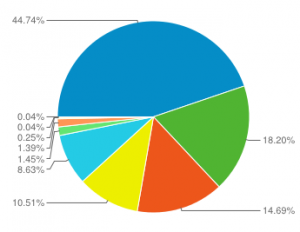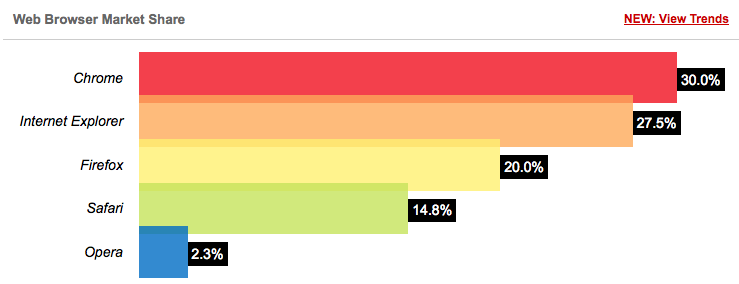Adblock became a synonym for a plugin or Add-on for different browsers and devices to block advertisements. If you surf the web using such a plugin, you will see almost no ads. No blinking banners, no disturbing pop-ups. On the opposite site, you as a website owner who finances his business or hobby just with advertisements, are afraid of this plugin, because it minimizes your income. Does it really? There are a lot of wild guesses about the usage of Adblock. In this article, we are going over some Adblock facts to help you understand the Adblock users to estimate the impact of it on your sites income.
Who uses Adblock?
To roughly estimate the number of Adblock users your site might have, you should know about the history of Adblock. The development of Adblock started in the early days of the Firefox browser in 2002. In 2005 the original add-on was forked into Adblock Plus to be completely rewritten a year later. It was in 2006, when Adblock started its uprising against annoying advertisements. As you see from this article from New York Times, in 2007 Adblock was like the Firefox browser still considered a niche. Since than, the plugin became more and more popular among Firefox users and nowadays already exists in some ways for Google Chrome, Safari and Internet Explorer. Even for the Internet Explorer? Yes, but from what we see, it is not common among these users and since the IE is still the default or at least pre-installed browser on most desktop computers, Adblock for Internet Explorer might be the least of your problems.
How many Adblock users are there?
Adblock started with Firefox
To answer the question on the number of Adblock users we might start looking at the statistics provided by the statistics board of Adblock Plus. There you can see a number of over 191 million total downloads and about 16 million daily users. Considering one migh have installed the plugin every time he bought a new computer, the 191 million might shrink a bit. The 16 million though might be impressive, if you are living in Germany with “just” above 50 million internet users. Considered worldwide, this is still a small number.
Adblock for other browsers
The Adblock plugin for Chrome claims to have above 10 million users. Having a look at the w3counter browser statistics, Chrome is a lot more popular than Internet Explorer and Firefox, but as you can easily see has a less penetration with Adblock users than Firefox. This is based on the facts from above that Adblock started with Firefox.
From what I see, there is a working Adblock for Safari and for Internet Explorer. But both seem to be less integrated and distributed than for the browsers mentioned above.
Adblock is tech savvy
Beside these hard facts, there are also soft facts to take into consideration. Adblock is still an add-on and seems to be big on Firefox and Chrome. This narrows down Adblock users to be at least able to install a non-default browser and an add-on. So lets expect these internet users to be a more tech and software savvy or at least interested group. If you are running a site about common topics like gardening, you might have a smaller Adblock problem than techcrunch.
Just an additional side note: web statistics like Google Analytics can get (ad)blocked as well using Adblock or its siblings. It is the same with a lot of other scripts like Facebooks Like-Buttons.
YOUR Adblock users
Which browsers do your visitors use?
What does the above mean for your site? I wasn’t able to find a statistic about downloads of the mentioned browsers to roughly calculate the percentage of Adblock users for each of them. Anyway, it is easy to say that the browser distribution is one of the key criteria to get a rough estimate. Be careful to not use the official statistics for this, but your own numbers. Here a quick example from one of our own German platforms www.wort-suchen.de.
Be aware of external numbers
For January 2013, the w3counter statistics estimates the distribution of the Internet Explorer with 27.5% worldwide. The browser statistics of w3schools.com, a site about website programing, has only 14.3% of its visitors using the IE, because tech savvy people tend to use other browsers (see below). The German site www.browser-statistik.de measured the IE market share with 18.8%. In Germany, Chrome is even less distributed and Firefox has the biggest market share with about 37.3%.
I took a German example to show you the difference in browser usage between countries. Easy to see you should not beleave worldwide or other external numbers. Use your own web analytics to get YOUR numbers.
Getting deeper into the numbers
In our overall statistics, almost 45% of wort-suchen.de’s visitors use the Safari browser. Only 18% use Firefox followed by Android browser with about 15%. As you might guess, this indicates a high level of mobile users on our site. Wait, is the number of visitors really the right metric here? Wouldn’t it be better to measure page views?
It depends on the kind of ads you are running. If you get payed by page impressions than you should switch the statistisc to page views. In our case, the share of Safari would shrink to only about 36% and Firefox rise to 25%. You can also read the statistics for new visitors, because they might be more eager to click on an ad when still searching for what they came for. For now, we won’t go deeper into this.
Since we also optimize our advertising income for different devices, we should definitely analyze the browser statistics separating the numbers by mobile and desktop devices. So on desktop devices, the Firefox browser has a share of about 45% among our visitors, followed by the Internet Explorer with about half of this share. On mobile devices Safari and Android claim the first two places.
Interpreting this data, we might expect a higher number of Adblock users amongst our desktop users. On the other hand, our site is not very tech related and more visitors than the average use the Internet Explorer. So I don’t expect the number to be very concerning and the reason we can’t affort another 1 or 2 more employees.
What’s next?
Understanding what Adblock is, where it came from and how it is distributed helps you to estimate the impact on your advertisement income. Anyway, I am still missing a reliable number and so started working on a new WordPress plugin that measures the exact number of Adblock users on our site. I am planing on releasing it so keep in touch with our site. I am also going to publish the numbers of Adblock users from two of our sites and give advice on how to minimize Adblock users.
If this information helped and motivated you to look into your own statistics, please share them with us. Do you think your site is threatened by Adblock?




Very informative article post.Really thank you! Will read on…
After a few hours of installing blockAlyzer I went back and checked. It said 8% of my visitors were using adblock. I thought that was pretty decent. I went back 48 hours later and that percentage had grown to FORTY PERCENT(40%) …. of roughly 15,000 page views nearly 5,000 of them were viewed by a browser blocking ads.
that’s a back-breaker. But your plug in rocks! thanks so much
Hi Ed, thank you for your great feedback! Did you have a look into your webstats to check for some of the possible reasons for your relatively high amount of adblock users?
Thomas
Pingback: Understanding your users with Google Analytics
Pingback: Los misterios del ad-blocking » El Blog de Enrique Dans
Pingback: Los misterios del ad-blocking